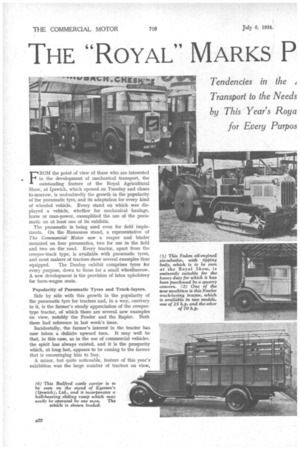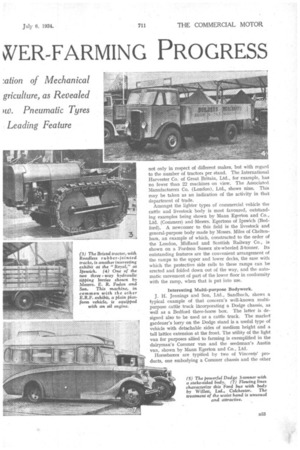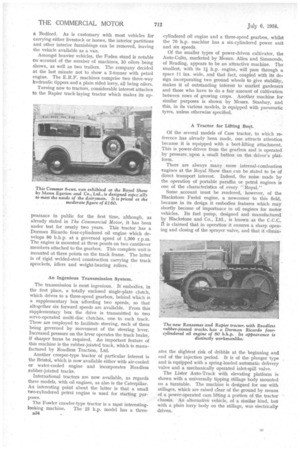THE "ROYAL" MARKS P NER-FARMING PROGRESS
Page 50

Page 51

Page 52

If you've noticed an error in this article please click here to report it so we can fix it.
ROM the point of view of those who are interested • in the development of mechanical transport, the outstanding feature of the Royal Agricultural Show, at Ipswich, which opened on Tuesday and closes to-morrow, is undoubtedly the growth in the popularity of the pneumatic tyre, and its adaptation for every kind of wheeled vehicle. Every stand on which was displayed a vehicle, whether for mechanical haulage, horse or man-power, exemplified the use of the pneu matic on at least one of its exhibits.
The pnerrna tic is being used even for field implements. On the Ransomes stand, a representative of The. Commercial Motor saw a reaper and binder
mounted on four pneumatics, two for use in the field and two on the road. Every tractor, apart from the creeper-track type, is available with pneumatic tyres, and most makers of tractors show several examples thus equipped. The Dunlop exhibit comprises tyres for every purpose, down to those for a small wheelbarrow. A new development is the provision of latex upholstery for farm-wagon seats.
Popularity of Pneumatic Tyres and Track-layers. Side by side with this growth in the popularity of the pneumatic tyre for tractors and, in a way, contrary to it, is the farmer's steady appreciation of the creeper type tractor, of which there are several new examples on view, notably the Fowler and the Rapier. Both these had reference in last week's issue.
Incidentally, the farmer's interest in the tractor has now taken a definite upward turn. It may well be that, in this case, as in the use of commercial vehicles, the spirit has always existed, and it is the prosperity
which, at long last, appears to be corning to the farmer that is encouraging him to buy.
A minor, but quite noticeable, feature of this year's exhibition was the large number of tractors on view, not only in respect of different makes, but with regard to the number of tractors per stand. The International Harvester Co. of Great Britain, Ltd., for example, has no fewer than 22 machines on view. The Associated Manufacturers Co. (London), Ltd., shows nine. This may be taken as an indication of the activity in that department of trade. Amongst the lighter types of commercial vehicle the cattle and livestock body is most favoured, outstanding examples being shown by Mann Egerton and Co., Ltd. (Cotnrners) and Messrs. Egertons of Ipswich (Bed ford). A newcomer to this field is the livestock and general-purpose body made by Messrs. Miles of Chelten ham, an example of which, constructed to the order of the London, Midland and Scottish Railway Co., is shown on a Fordson Sussex six-wheeled 3-tonner. Its outstanding features are the convenient arrangement of the ramps to the upper and lower decks, the ease with which the protective side rails to these ramps can be erected and folded down out of the way, and the automatic movement of part of the lower floor in conformity with the ramp, when that is put into use. Interesting Multi-purpose Bodywork.
J. H. Jennings and Son, Ltd., Sandbach, shows a typical example of that concern's well-known multi purpose cattle truck incorporating a Dodge chassis, as well as a Bedford three-horse box. The latter is designed also to be used as a cattle truck. The marker gardener's lorry on the Dodge stand is a useful type of vehicle with detachable sides of medium height and a tall lattice extension at the front. The utility of the light van for purposes allied to farming is exemplified in the dairyman's Cornmer van and the seedsman's Austin van, shown by Mann Egerton and Co., Ltd. Horseboxes are typified by two of Vincents' pro ducts, one embodying a Cormner chassis and the other
a Bedford. As is customary with most vehicles for carrying either livestock or horses, the interior partitions and other interior furnishings can be removed, leaving the vehicle available as a van.
Amongst heavier vehicles, the Foden stand is notable Oil account of the number of machines, 10 oilers being shown, as well as two trailers. The company decided at the last minute not to show a 2-tonner with petrol engine. The E.R.F. machines comprise two three-way hydraulic tippers and a plain sided lorry, all being oilers.
Turning now to tractors, considerable interest attaches to the Rapier track-laying tractor which makes its ap
pearance in public for the first time, although, as already stated in The Commercial Motor, it has been under test for nearly two years. This tractor has a
Dorman Ricardo four-cylindered oil engine which develops 80 b.h.p. at a governed speed of 1,300 r.p.m. The engine is mounted at three points on two cantilever members attached to the gearbox. This complete unit is mounted at three points on the track frame. The latter is of rigid welded-steel construction carrying the track sprockets, idlers and weight-bearing rollers.
An Ingenious Transmission System.
The transmission is most ingenious. If embodies, in the first place, a totally enclosed single-plate clutch, which drives to a three-speed gearbox, behind which is
a supplementary box affording two speeds, so that altogether six forward speeds are available. From this supplementary box the drive is transmitted to two servo-operated multi-disc clutches, one. to each track. These are employed to facilitate steering, each of them being governed by movement of the steering lever.
Increased pressure on the lever operates the track brake, if sharper turns be required. An important feature of this machine is the rubber-jointed track, which is manufactured by Roadless Traction, Ltd.
Another creeper-type tractor of particular interest is the Bristol, which is now available either with air-cooled.
or water-cooled engine and incorporates Roadless rubber-jointed tracks.
International tractors are now available, as regards three models, with oil engines, as also is the Caterpillar. An interesting point about the latter is that a small two-cylindered petrol engine is used for starting purposes.
The Fowler crawler-type tractor is a most interesting
looking machine. The 25 h.p. model has a threes34
cylindered oil engine and a three-speed gearbox, whilst the 70 h.p. machine has a six-cylindered power unit and six speeds.
Of the smaller types of power-driven cultivator, the Auto-Culto, marketed by Messrs. Allen and Simmonds, of Reading, appears to be an attractive machine. The smallest, with its 1-1 h.p. engine, will pass through a space 11 ins, wide, and that fact, coupled with its design incorporating two ground wheels to give stability, makes it of outstanding interest to market gardeners and those who have to do a fair amount of cultivation between rows of growing crops. Another machine for similar purposes is shown by Messrs. Stanhay, and this, in its various models, is equipped with pneumatic tyres, unless otherwise specified.
A Tractor for Lifting Beet.
Of the several models of Case tractor, to which reference has already been made, one attracts attention because it is equipped with a beet-lifting attachment. This is power-driven from the gearbox and is operated by pressure. upon a small button on the driver's platform.
There are always many more internal-combustion engines at the Royal Show than can be stated to be of direct transport interest. Indeed, the noise made by the operation of portable paraffin or petrol engines is one of the characteristics of every "Royal."
Some account must be rendered, however, of the Blackstone Fuelol engine, a newcomer to this field, because in its design it embodies features which may shortly become of importance in oil engines for motor vehicles. Its fuel pump, designed and manufactured bty Blackstone and Co., Ltd., is known as the C.C.C. n is claimed that in operation it ensures a sharp opening and closing of the sprayer valve, and that it elimin ates the slightest risk of dribble at the beginning and end of the injection period. It is of the plunger type and is equipped with a spring-loaded automatic delivery
valve and a mechanically operated inlet-spill valve.
The Lister Auto-Truck with elevating platform is shown with a universally tipping stillage body mounted on a turntable. The machine is designed for use with stillages, which are raised clear of the ground by means of a power-operated cam lifting a portion of the tractor chassis. An alternative vehicle, of a similar kind, but with a plain lorry body on the stillage, was electrically driven.




































































































